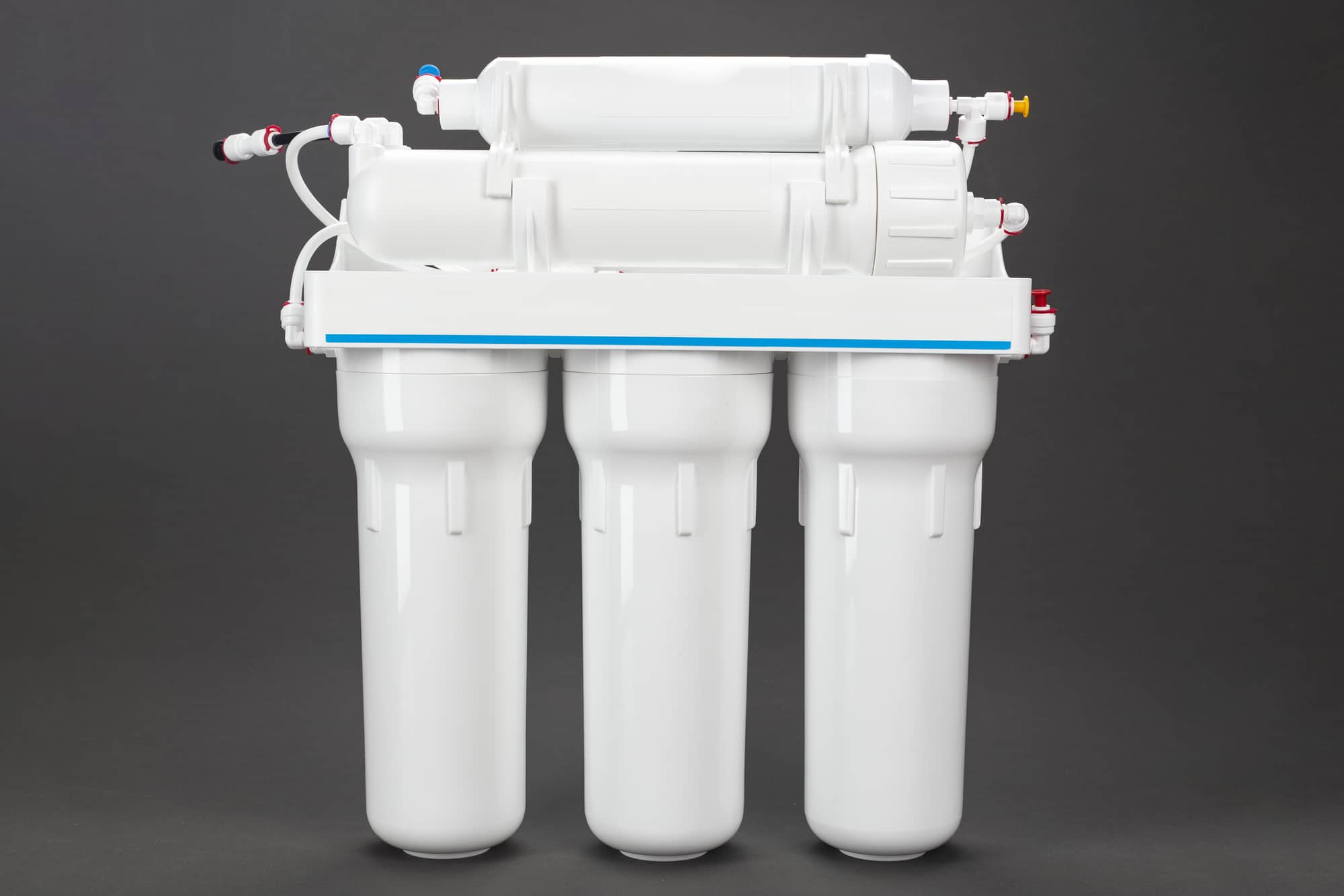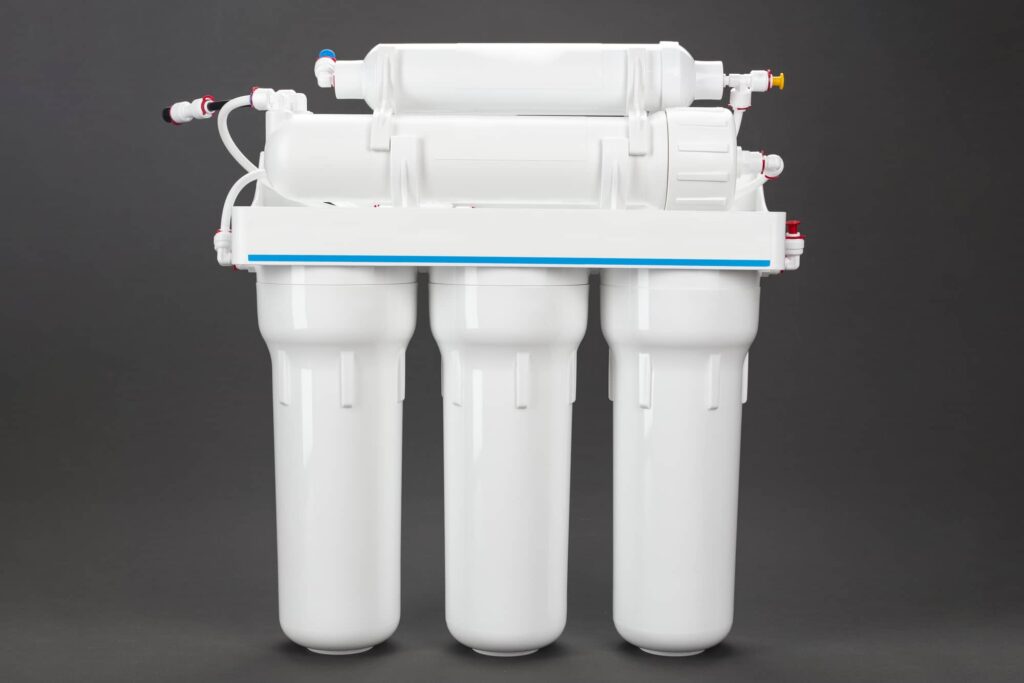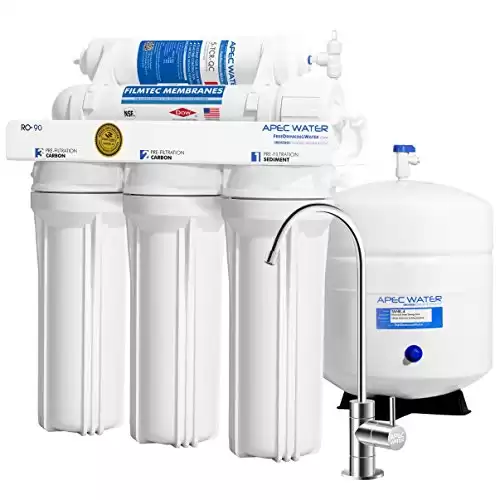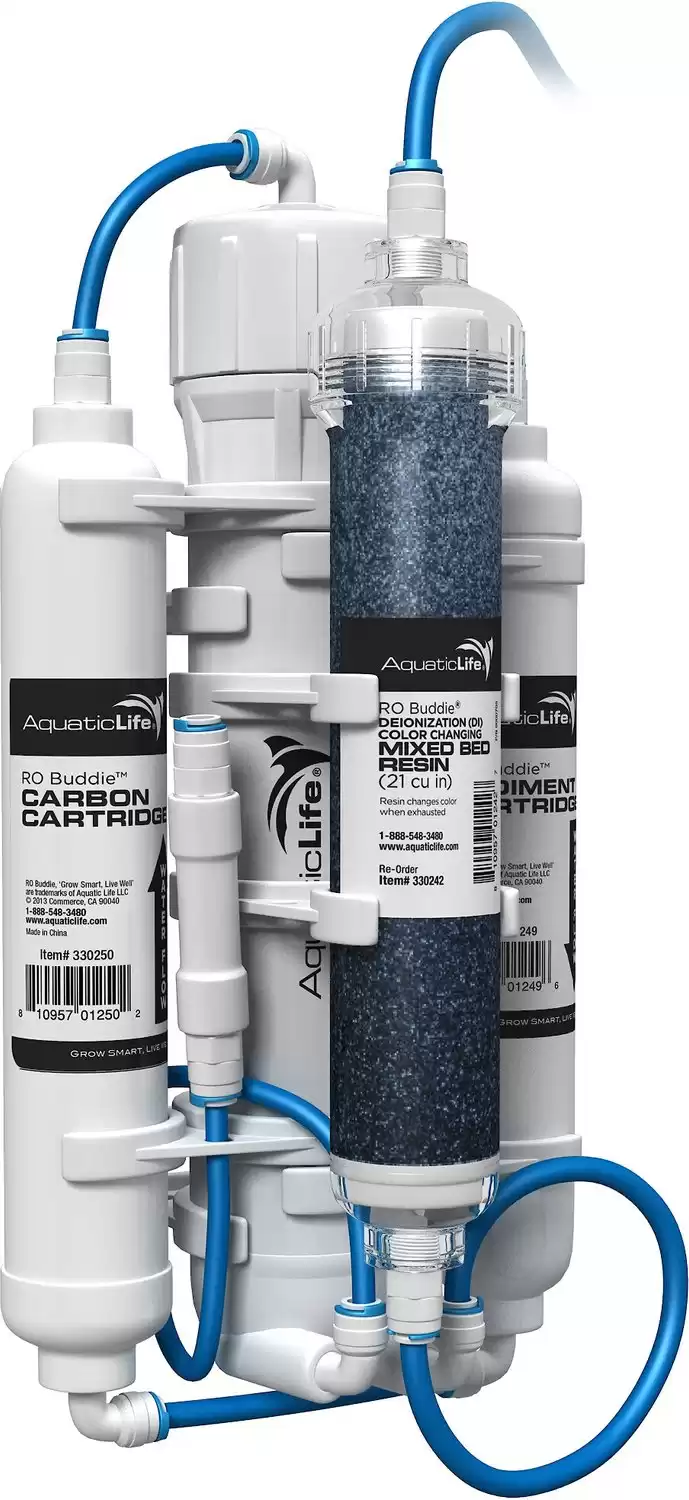If you’re new to keeping marine fish or a reef tank, you’ll need to learn all about RO/DI systems.
City water can contain heavy metals and chemicals that are potentially harmful to aquatic life. That’s where RO/DI systems can be extremely beneficial for your home tank in providing a healthy environment for your fish.
In fact, if you have a reef aquarium, a high-quality RO/DI system is an essential piece of equipment for your tank!
Read this guide to find out more about RO/DI systems, what they do, and how they work.
|
4.5
|
4.5
|
4.0
|
What Is an RO/DI System?
If you have a saltwater aquarium or a coral reef tank and you want to give your fish and other livestock purer water, you need an RO/DI system.
A RO/DI system removes any dangerous contaminants, such as heavy metals, making the water safe for you to use in your fish tank.
RO and DI are two separate systems, although they are almost identical. The difference is that the combined RO/DI system has an additional filtration stage known as Deionization (DI), which removes all the dissolved particles from the water (0 TDS).
So, the two systems available to aquarists are RO (Reverse Osmosis water system) and RO/DI (Reverse Osmosis Deionization system).
The main difference between the two systems is the degree of water purity that you get. Generally, RO systems are used to produce purified water for aquariums and safe drinking water. RO/DI systems produce water that’s 99.9% pure for use in saltwater aquariums and scientific applications.
In this guide, we focus primarily on RO/DI systems for the marine or reef aquarist.
Stages
When you’re looking for an RO/DI system, you’ll notice that there are several stages of filtration to choose from, depending on the degree of water purification you want and the quality of your tap water.
4-stage
The 4-stage RO/DI system is just about the most popular with aquarists, as it’s the most portable and affordable option. Also, you can upgrade and customize your system to suit your aquarium water requirements and your source water conditions.
A 4th stage system will produce 0 TDS water quality in most setups and provides ideal water filtration for fish nano tanks and for hobbyists who have a relatively low budget.
5-stage
We usually recommend a 5-stage unit as that includes an additional carbon filter. A carbon filter removes many of the commonly used disinfectants in the domestic water supply, including Chloramines and chlorine.
A 5-stage system is best for most reef tanks since those disinfectants will quickly use a single carbon block, so having two carbon filters will provide you with much better protection.
6-stage
With a 6-stage filter, you get all the benefits of the 5-stage system plus the bonus of two DI resin filters as the 6th stage. This ensures that contaminants can’t get through the DI resin if the filter isn’t replaced.
These systems are perfect for serious aquarists with multiple or very large tanks that have a strong flow rate and a heavy demand for RO/DI fresh water per day.
7-stage
If you have a large, complex reef aquarium, you probably need a 7-stage system for optimal water filtration.
These systems offer you several additional features, including a finishing stage that includes dual carbon filters, as well as multiple deionization filter stages.
This is the most economical way of running a deionization filter as it enables you to target the specific contaminants that exist in your water source.
Generally, a 7-stage system is the most expensive option and it periodically does require replacement filters, too.
Why Do I Need an RO/DI System?

An RO/DI system is essential in a marine aquarium or saltwater tank because your tap water is packed with contaminants that can trigger algae blooms, even if you treat the water with water conditioners.
Though this might be fine for freshwater aquariums, it’s not great for a reef tank containing sensitive corals and sponges that can be suffocated by heavy algae growth.
In the hobby, the main measure used for containment assessment in tap water is referred to as TDS or Total Dissolved Solids. TDS is comprised of organic matter, dissolved minerals, and inorganic salts that are found in tap water. A high volume of TDS in the source water means that you are encouraging algae to bloom, which is not good news for the marine life in your tank.
Ideally, you want 0 TDS in a marine water tank. However, the average TDS for tap water can be anywhere between 150 and 400, depending on whereabouts you live.
If you use an RO system alone, your TDS water ratio will be around 10 to 20 TDS, which is much better, although still not suitable for use in a reef tank.
That’s why we recommend a multi-stage RO/DI unit that includes a deionization stage, which gives you 0 TDS.
Top 5 Best RO/DI Systems
Now, let’s cut to the chase with our reviews of the best units that are currently on the market.
There’s a wide range of products to choose from, so we’ve made things simpler for you by picking out these top five excellent systems.
LIQUAGEN 5 Stage RO/DI System
- Filter system is designed to produce very pure 0 ppm water.
- Air-leak testing and leak-free fittings make for a long-lasting, durable filter.
- It’s BPA-free so your finned friends can enjoy a safe swimming environment.
The LIQUAGEN system is an excellent piece of kit that is highly recommended by many users.
This system is pretty affordable and very effective, providing your livestock with the ultra-pure water that they need to thrive.
Unlike many similar units, this one comes already set up and ready to install in as little as five minutes!
This RO/DI system easily handles relatively soft city water, as well as some well water that contains up to 700 ppm of total dissolved solid particulates (TDS). We recommend that you choose this system if your tap water contains under 350 ppm of TDS.
In that case, the manufacturer guarantees that the outcoming water contains 0 ppm of TDS, provided that those requirements are met.
Things We Like:
- Two-year warranty and lifetime customer support
- Ready set up and simple to install
- Very affordable
- Produces completely purified water
Room for Improvement:
- This system won’t produce zero TDS water if your incoming water source contains over 350 TDS.
AQUATICLIFE Twist-in-4 Stage RO/DI System
- 75 GALLONS OF DEIONIZED WATER PER DAY – AquaticLife 4-stage reverse osmosis deionization system reduces salt, calcium, and other metallic ions from water leaving you with clean, clear water for residential use.
- REDUCES TDS TO ZERO – The RO Membrane Filter 75 GPD effectively removes up to 98 percent of the Total Dissolved Solids (TDS) in water.
The AQUATICLIFE system is an excellent choice for a beginner with a saltwater aquarium since it’s incredibly simple to install. Also, changing the cartridges is quick and hassle-free.
The unit is reportedly fairly efficient in reducing TDS and is also very affordable, making this ideal if you’re on a budget and you have hard tap water to deal with.
The main drawback to this piece of equipment is that it doesn’t work if you have a Gallons Per Day rate (GPD) of 75 operating in your tank. However, most domestic tanks have a lower Gallons Per Day rate than that, so this low GPD capacity is not necessarily a problem.
Things We Like:
- Excellent value for money
- Simple and quick to install and maintain
- Highly effective even for very hard water
- Reliable customer service
- Air-leak tested, leak-free fittings
- Long-lasting filters
Room for Improvement:
- Somewhat slower than advertised
- Booster pump required to increase GPD rates and pressure
Aquatic Life RO Buddie Four Stage Osmosis System
- Also includes the mixed bed resin cartridge, which removes the remaining total dissolved solids from the water.
- Small footprint of this unit makes it easy to place under cabinets or in limited spaces.
Although this excellent unit is cheap compared to many others, the unit works well enough, and it will produce zero TDS if the DI filter is fitted correctly.
This is a small, portable, compact unit that doesn’t take up much space and uses RO/DI filter cartridges. Although the deionization cartridge in the unit is small, it only starts changing color after processing 150 gallons of RO water. The unit comes with clear installation instructions and is very simple to install.
On the downside, the unit is quite slow, but you can boost its performance by adding a pressure booster pump. That said, this unit is fine for a small reef setup or a nano tank.
Things We Like:
- Affordable price
- Effective and easy to use
- High-quality components
- The compact unit makes this a great choice for nano reef tanks.
Room for Improvement:
- The unit is quite slow
- Wastewater volume is rather high at a 1:3 ratio
iSpring RCC7AK 6-Stage Reverse Osmosis System
- Certified to NSF/ANSI 58, 6-Stage Alkaline Remineralization Layered Filtration - Exclusively designed to restore the natural alkalinity and mineral balance of water.
- LOW MAINTENANCE - Transparent 1st stage housing for easy visual inspection. Three extra long life pre-filters to remove large contaminants and protect RO membrane.
This manufacturer certainly knows how to look after its customers! With the system, you get an instruction manual and links to several online videos, where you can find a step-by-step guide to setting up and using the unit.
You also get lifetime customer support, which is handy if you have any questions or problems with the unit.
The unit is very easy to assemble and produces super-clean, pure water for your reef aquarium, even though this five-stage system doesn’t use a DI cartridge.
To guard against aquarium crashes, the Spring RCC7AK features a sixth unit, the Alkaline Remineralization filter. This feature recovers essential minerals that might have been lost during the filtration process, making this sweet-tasting water also safe for human consumption!
Things We like:
- Simple to install and plenty of instructions provided
- Pure water thanks to five stages of RO filtration
- Lifetime customer support
- Remineralization stage feature
- Nickel faucets and pressurized storage tank
Room for Improvement:
- The filtration process can be rather slow at 75 GPD
APEC Water Systems RO-90 Ultimate Series
- Enjoy unlimited ultra-fresh, clean, great tasting water right at home. Save money, time and hassle of buying costly, bottled water
- Designed, engineered and assembled in USA, RO-90 is the most durable system in the industry to guarantee water safety & your health
APEC is a US manufacturer that’s been producing water filtration equipment for over two decades.
This major player provides a two-year warranty on any of the RO systems, which is sure to give you peace of mind, as this is not a cheap purchase. Customer support is also excellent.
This five-stage RO water system might be silent running, but it still produces excellent results, removing up to 99% of contaminants from your aquarium water. Although the system doesn’t use a DI cartridge, it still produces reef-safe, high-quality water and is excellent for reducing high levels of nitrate in saltwater aquariums.
The filter system produces a huge capacity of 90 gallons of clean water per day for your tank, provided that you keep a water pressure of at least 60 psi. That makes this unit a perfect choice for a large reef tank.
The system is simple to set up without the assistance of a plumber, taking around two hours at most for installation.
Things We like:
- Super-efficient at removing high levels of nitrate from the water
- Produces super-clean, reef-safe water for corals
- Includes a two-year warranty
- Extremely quiet operation
- Includes a water storage tank
- Manufacturer provides lifetime customer care
Room for Improvement:
- Some users found the membrane housing difficult to open
How To Maintain an RO/DI System
For your RO/DI system to continue working to its optimum, you need to keep on top of filter maintenance. This means replacing all the sediment filters regularly.
If you allow the filters to become clogged, the system won’t produce sufficient fresh saltwater for your livestock and TDS could even begin to leak through the system into your tank.
One of the good things about RO/DI systems is that they usually last you a lifetime, which is why most manufacturers are happy to provide you with a lifetime guarantee on their products.
Overall, RO/DI units are one of the most reliable systems you can install in your aquarium and are one of the most important, too.
Even freshwater tanks can benefit from the use of these systems, especially if you keep fish species that are highly sensitive to water parameters and conditions.
RO/DI Sediment Pre-filter
The RO/DI sediment pre-filter needs to be replaced at least every six months. Replacement might be required sooner for areas with TDS water of over 400.
RO/DI Carbon Cartridges
When a carbon filter cartridge is close to the end of its life, your membrane will finish up carrying a heavier workload, which can lead to bacterial growth in the chamber.
To ensure this doesn’t happen, you’ll need to carry out carbon filter replacements every six months or so.
Reverse Osmosis Membranes
RO membranes are the workhorse of all filtration systems, and they are the most important element of the system to replace.
Ideally, you want to replace your RO membranes every 9 to 12 months to keep the filtering process efficient.
However, you can sometimes make the membranes last for longer if you use a flush kit and a clean water source.
To gauge that, check what degree of TDS is coming out at the membrane stage. If the number you’re getting is much higher than usual, it’s probably time to change the membrane.
Deionization Cartridge
The DI cartridge is the final stage of the RO/DI system. You can easily tell when it’s time to replace the cartridge, as the resin in the cartridge will gradually change color over time.
You can also take a reading from your TDS meter and change the cartridge once the meter reads 1 to 2 TDS.
Also, the quality of the DI cartridge and the efficiency of your system will influence how long the cartridge lasts over time.
Final Thoughts
If you own a marine or reef saltwater tank, you’ll need an RO/DI system to provide your fish and other livestock with clean water that’s free from contaminants.
Generally, 5-stage filtration is ideal, although you might want to go for something more complex and with more features, such as a 7-stage filtration system if you have a very large tank or multiple aquariums.
Although we’ve included products that cover a wide price range in our list, we recommend that you buy the best unit you can afford.
An efficient unit will save you money over time, as it will be more reliable and the cartridges will probably last longer.









